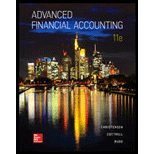
Concept explainers
a
Introduction: When a parent sells subsidiary shares, a gain or loss normally occurs and is recorded on the seller’s books, which needed to be recognized in consolidated net income. Under ASE 810, changes in a parent’s ownership interest in a subsidiary while the parent retains control require an adjustment to the amount assigned to the non-controlling interest to reflect its change in ownership in the subsidiary. Any difference in fair value of the controlling interest results in an adjustment to the
The effect of sales of MT shares to BM Company on consolidated statements of HM, if BM is an unrelated company.
b
Introduction: When a parent sells subsidiary shares, a gain or loss normally occurs and is recorded on the seller’s books, which needed to be recognized in consolidated net income. Under ASE 810, changes in a parent’s ownership interest in a subsidiary while the parent retains control require an adjustment to the amount assigned to the non-controlling interest to reflect its change in ownership in the subsidiary. Any difference in fair value of the controlling interest results in an adjustment to the stockholders’ equity attributable to the controlling interest, through an adjustment to additional paid-in capital.
The effect of sales of MT shares to BM Company on consolidated statements of HM, if HM holds 60 percent of BM’s voting shares.
Want to see the full answer?
Check out a sample textbook solution
Chapter 9 Solutions
Advanced Financial Accounting
- Daley Industries wishes to develop a single predetermined overhead rate. The company's expected annual fixed overhead is $420,000, and its variable overhead cost per machine hour is $3.25. The company's relevant range is from 200,000 to 650,000 machine hours. Daley expects to operate at 520,000 machine hours for the coming year. The plant's theoretical capacity is 850,000 machine hours. The predetermined overhead rate per machine hour should be: a. $3.85 b. $4.06 c. $3.75 d. $4.25arrow_forwardWhat was the total amount of deductions?arrow_forwardgeneral accountingarrow_forward
- Owner's equity for our company is $980,000, and total liabilities are $377,000. The company paid $50,000 in dividends during the year. What do our total assets equal? A. $1,250,000 B. $1,750,000 C. $1,500,000 D. $1,357,000 MCQarrow_forwardI need help solving this financial accounting question with the proper methodology.arrow_forwardPlease show me the correct approach to solving this financial accounting question with proper techniques.arrow_forward
- Can you help me solve this financial accounting problem using the correct accounting process?arrow_forwardCan you solve this general accounting question with the appropriate accounting analysis techniques?arrow_forwardCan you solve this general accounting question with accurate accounting calculations?arrow_forward
 Financial Reporting, Financial Statement Analysis...FinanceISBN:9781285190907Author:James M. Wahlen, Stephen P. Baginski, Mark BradshawPublisher:Cengage Learning
Financial Reporting, Financial Statement Analysis...FinanceISBN:9781285190907Author:James M. Wahlen, Stephen P. Baginski, Mark BradshawPublisher:Cengage Learning
